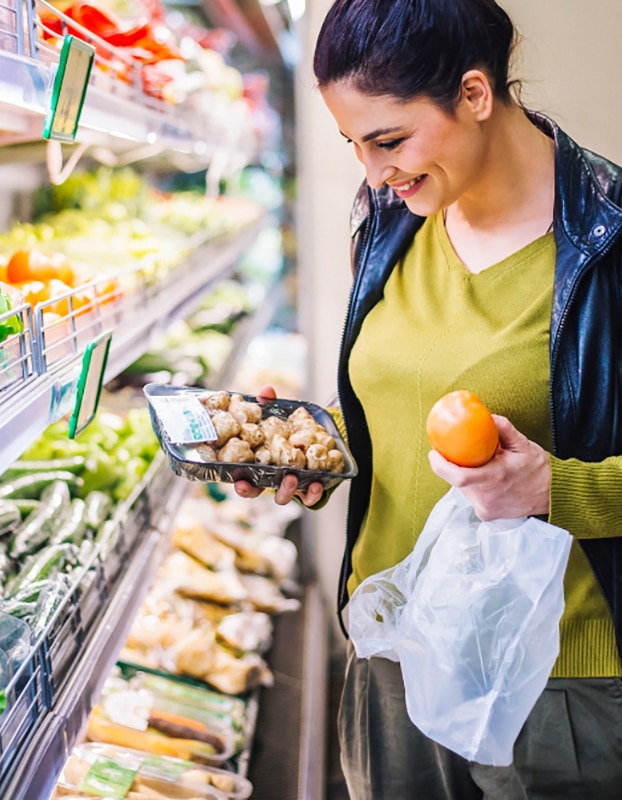
HEALTH
BENEFITS
Salt is made up of sodium chloride (NaCl) and is essential for the body to function properly! It plays a key role in maintaining the body’s water balance, which is essential for our nervous system and muscle function.
Salt can also contain other minerals, and can be enriched, with iodine or fluoride for example.
Despite this essential function, we know that too much salt can encourage the development of certain diseases. Excessive consumption is a risk factor for arterial hypertension and cardiovascular disease.
NUTRITIONAL
VALUES
THE RIGHT TIME
TO EAT IT
Salt is available all year round.
VEGETABLE GARDEN
OR CITY BALCONY
No surprises there, but you cannot produce salt at home, whether in your vegetable garden or on a city balcony! There are, however, many other seasonings you can use to replace or complement table salt, and thereby reduce your salt intake without losing taste.
Think of the many aromatic herbs you can use to spice up your cooking, such as thyme, rosemary and parsley… Not to mention garlic, shallots, onions, ginger, leeks, radishes, rocket or even purslane, which can be added to all kinds of foods to boost their flavour.
Aromatic herbs are easy to grow at home, in the garden or on a balcony, or even indoors.
CHOOSING
AND STORING
Table salt or sodium chloride comes in several forms and should be stored in a dry place.
TIPS
AND TRICKS
All sorts of foods contain salt, both savoury and sweet. We add it to almost every recipe. So how can we eat less salt? Let’s go back to the main purpose of salt: on the one hand, it intensifies and enhances the flavour of a dish, and on the other, it is used to preserve food.
For taste, we just need to find tricks to enhance flavour in different ways. This is where vegetables, herbs and spices come into play!
Don’t forget that salt can be hiding in many different foods, such as:
- ready meals,
- breads, rusks, pastries,
- cured meats,
- cheese,
- soups,
- crisps and savoury snacks,
- smoked and salted fish,
- sauces and condiments.
WHAT IS THE ENVIRONMENTAL
IMPACT OF SALT?
We can find out more from its PEF (Product Environmental Footprint) score! This is a score established by Agribalyse*. It takes into account every stage in the life cycle of a vegetable or food: how it’s cultivated, the impact of processing and transport, etc. The lower the score, the less impact it has on the environment.
- White salt, with no added iodine or fluoride: 0.08
- Raw beef steak: 2.77
*Figures drawn from the Agribalyse database, which calculates the environmental score of different types of food. This unique score is a weighted average of 16 indicators, calculated according to the European PEF methodology. It does not correspond to an environmental label or ‘eco-score’.
CO2 equivalent: for 100g of white food salt: 0.06kg of CO2 eq, or as much as from 1.77g of raw beef steak.

CAN EVERYONE EAT IT?
It is advisable to limit salt intake from early childhood. Food prepared for children under the age of one should not be salted. From one, children can join the rest of the family at the table and eat the same food. It’s better not to add extra salt to the dish, as basic foods such as bread provide sufficient salt. It’s a win-win for the whole family!
For adults, the recommended limit is 5g of salt per day, equivalent to 2.4g of sodium.
Salt is a question of habit. Either your taste buds are used to it or not. That’s why some people will automatically reach for the salt, before even tasting their food. Others will quickly find a dish too salty. This latter group is best placed to avoid an excess salt intake.
How can we eat less salt ?
- Eat fewer salty ready meals
- Use less salt when cooking
- Keep the salt off the table
- Use herbs and spices to enhance flavour
- Play around with vegetables
- Get your taste buds used to eating less salt
- Avoid salted fish
WHERE DOES IT COME FROM?
THE ORIGINS AND VARIETIES OF SALT
Cooking salt is generally extracted from salt marshes in the sea. Salt extractors are known as sauniers on the French Mediterranean coast, and paludiers on its Atlantic front. Salt can also be found in a deposit, such as the Khewra salt mine in Pakistan, from where pink Himalayan salt is extracted. Sea salt, coarse salt, iodised salt, fine salt, salt flakes… there’s plenty of choice!
* Latest survey on French eating habits, INCA 3, published in 2017.



 Artichoke
Artichoke  Flageolet Beans
Flageolet Beans  Vegetable garden: growing turnip
Vegetable garden: growing turnip 









